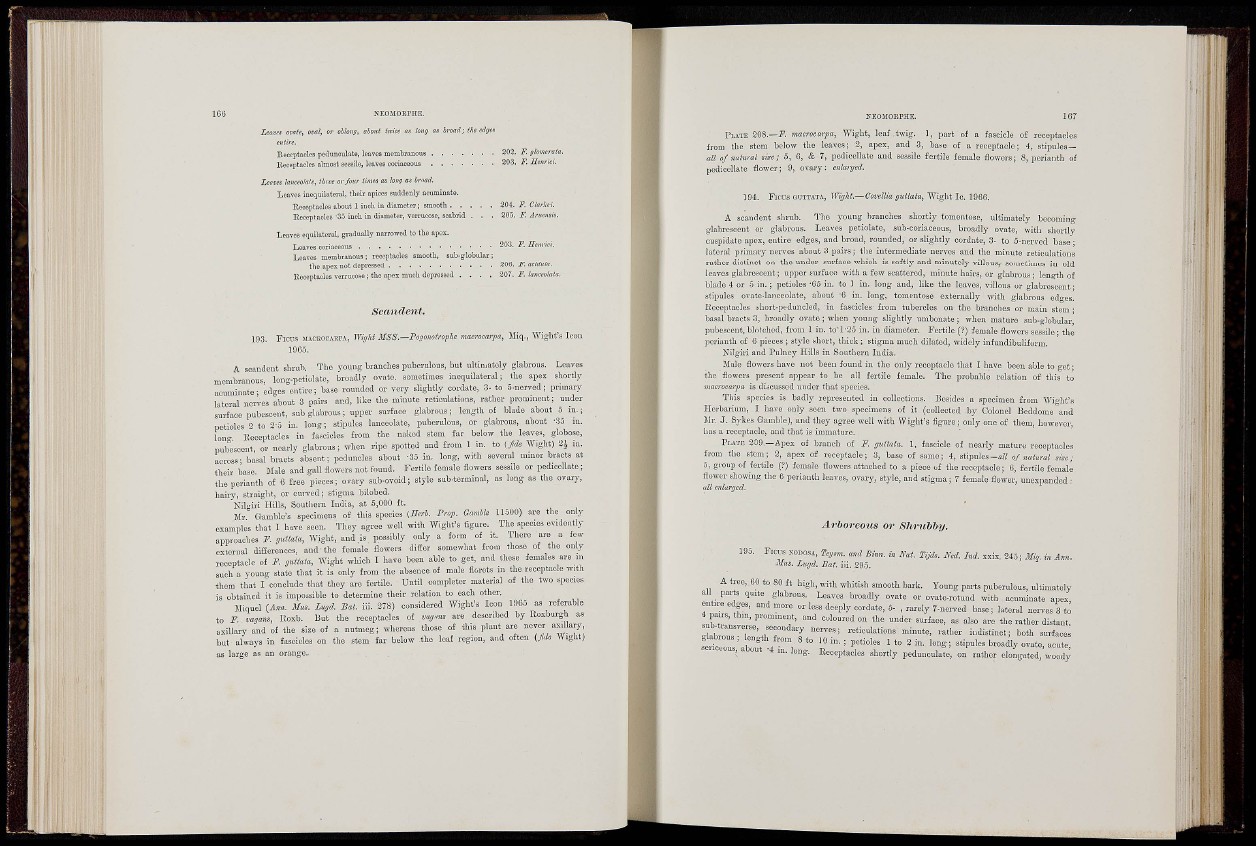
J
HEOMOEPHE,
Leaws ovete, oval, or oUong, aloxit twice as long as broad; the edges
enlire.
Beeeptacles pedunculate, leaves membranous 202. F. glomerata.
Receptacles almost sessile, leaves coriaoeouB 203. F. Eenrici.
Zeoves lanceolate, three or four iimea as long as brnad.
Leaves inequilateral, tlieir apices suddenly acuniiuate.
Eeeeptaoles atout 1 inch in diameter; smooth 204. F. Clarkei.
Eeceptaoles -35 inch in diameter, verrueose, soabrid , . . 205. F. Arucusis.
Leaves equilateral, gi'aduaUy nai'rowod to the apes.
Leaves coriaceous 203. F. Eenrki.
Leaves membranous; receptacles smooth, sub-globular;
the apes not depressed 206. F. acidula.
Beeeptacles ven-ucose; the apex much depi-essed . . . . 207. F. lanceolala.
Scandent.
193. Ticus MACROCAEPA, Wi(jM MSS.—Fogouoti-ophe macrocarjm, Miq,, Wight's Icon
1965.
A scandent shrub. The young branches pxibenilous, but ultimately glabrous. Leaves
membranous lono--petio!atc, broadly ovate, sometimes ineciuilateral; the apex shortly
acuminate- ed-es entire; base rounded or very slightly cordate, 3- to 5-nerved; primary
lateral nerves about 3 pairs and, like the minute reticulations, rather prominent; under
surface pubescent, sub glabrous; upper surface glabrous; length of blade about 5 in.;
petioles 2 to 2'0 in. long; stipules lanceolate, pubonilous, or glabrous, about -35 in.
lono- Eeceptacles in fascicles from the naked stem far below the leaves, globose,
pubescent, or nearly glabrous; when ripe spotted and from 1 in. to ijde Wight) in.
across- basal bracts absent; peduncles about -35 in. long, with several mmor bracts at
tlieir base. Male and gall flowers not found. Fertile female flowers sessile or pedicellate;
the perianth of 6 free pieces; ovary sub-ovoid; style sub-terminal, as long as the ovary,
hairy, straight, or curved; stigma bilobed.
Nil-'iri Hills, Soutliern India, at 5,000 ft.
Mr'' Gamble's specimens of this species {Uerl. Prop. Gamble 11500) are the only
examples that I have seen. They agree well with Wight's figure. The species evidently
approaches P. ^«ifei«, Wight, and .is possibly only a form of it. There are a few
external di£Eerenccs, and-the female flowers differ somewhat from those of the only
receptacle of F. guttata, Wight winch I have been able to get, and these females are m
such a young state that it is only from the absence of male florets in the receptacle with
them that I conclude that they are fertile. Until completer material of the two species
is obtained it is impossible to determine their relation to each other.
Miquel (Am. Mus. Lugd. Bat. iii. 278) considered Wight's Icon 1965 as referable
to F vagam, Rosb. But the receptacles of vag.ms are described by Roxburgh as
axillary and of the size of a nutmeg; whereas those of this plant are never axillary,
but always in fascicles on the stem far below the leaf region, a.id often {fide Wight)
as large as an orange..
PWTE 208.-2^. macrocarpa, Wight, leaf twig. 1, part of a fascicle of receptacles
from the stem below the leaves; 2, apex, and 3, base of a receptacle; 4, stipules —
all of natural sise; 5, 6, & 7, pedicellate and sessile fertile female flowers; 8, perianth of
pedicellate flower; 9, ovary: enlarged.
194. Ficus GUTTATA, Wight—CovelUa guttata, Wight Ic. 196G.
A scandent shrub. The young branches shortly tomentose, ultimately becoming
glabre,scent or glabrous. Leaves petiolate, sub-coriaceous, broadly ovate, with shortly
cuspidate apex, entire edges, and broad, rounded, or slightly cordate, 3- to 5-nerved base;
lateral primary nerves about 3 pairs; the intermediate nerves and the minute reticuJations
rather distinct on the under surface which is softly and minutely villous,- sometimes in old
leaves glabrescent; upper sm-face with a few scattered, minute hairs, or glabrous; length of
blade 4 or 5 in. ; petioles '65 in. to 1 in. long and, like the leaves, villous or glabrescent;
stipules ovate-lanceolate, about '6 in, long, tomentose externally with glabrous edo-es
Keceptacles .'•hort-peduncled, in fascicles- from tubercles on the branches or main stem -
basal bracts 3, broadly ovate; when young slightly umhonate; when mature sub-globular,
pubescent, blotched, from 1 in. to'1-25 in. in diameter. Fertile (?) female flowers sessile; the
perianth of 6 pieces ; style short, tliick ; stigma much dilated, widely infundibuiiform.
Nilgiii and Pulney Hills in Southern India.
Male flowers have not been found in the only receptacle that I have been able to get;
the flowers present appear to be all fertile female. The probable relation of this to
macrocarpa is di^cusscd under that species.
This species is badly rei^resented in collections. Besides a specimen from Wight's
Herbarium, I have only seen two specimens of it (collected by Colonel Beddome°and
Mr. J. Sykes Gamble), and they agree well with Wight's figure; only one of them, however
has a receptacle, and that is immature.
PLATE 209.—Apex of branch of F. guttata. 1. fascicle of nearly mature receptacles
from the stem; 2, apex of receptacle; 3, base of same; 4, s t i p u l e s—o f natural size;
5, group of fertile (?) female flowers attached to a piece of the receptacle; 6, fertile female
flower showing the 6 perianth leaves, ovary, style, and stigma; 7 female flower, unexpanded ;
all enlarged.
195.
Avhoreous or Shrtihhy.
Ficus KODOSA, Teym. and Binn. in IS^at. Tijds. Ned. Ind. sxix, 245; Miq. in Am.
Mtis. Lugd. Bat. iii, 295.
A tree, 60 to 80 ft high, with whitish smooth bark. Young parts puberulous, ultimately
all paints quite glabrous. Leaves broadly ovate or ovate-rotund witli acuminate apex
entire edges, and more or less deeply cordate, 5- , raz-ely 7-nei-ved base; lateral nerves 3 to
L b T ; coloured on the under surface, as also are the rather distant,
oiab o r reticulations minute, rather indistinct; both surfaces
>0 i n . ; petioles 1 to 2 in. long; stipules broadly ovate, acute,
beiiceous, about 4 m. long. Receptacles shortly pedunculate, on rather elongated, woody